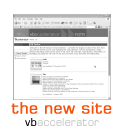
Detecting when another application is activated

In a form, there is a Deactivate event. Exactly what this method is for is hard to determine, because it hardly ever seems to fire. Ok, that's perhaps a little unfair - it never fires. One thing you certainly can't detect without a bit of additional work is when the user Alt-Tabs to another application. Detecting this can be useful, for example, when you the user is performing a drag or you're showing a pop-up tool window.
Detecting Activation and Deactivation
When a form in your application is activated or deactivated, Windows fires a WM_ACTIVATE message to the form. The wParam of this message tells you the reason the message has been fired:
- 0 - Form deactivated
- 1 - Form activated
- 2 - Form activated by a mouse click
The code to make this work is very simple with the Subclassing and Timer assistant:
' Subclassing object to catch Alt-Tab
Implements ISubclass
Private Const WM_ACTIVATE = &H6
Private Sub Form_Load()
' Start subclassing for WM_ACTIVATE
AttachMessage Me, Me.hwnd, WM_ACTIVATE
End Sub
Private Sub Form_QueryUnload(Cancel As Integer, UnloadMode As Integer)
' Clear up:
DetachMessage Me, Me.hwnd, WM_ACTIVATE
End Sub
Private Property Let ISubclass_MsgResponse(ByVal RHS As EMsgResponse)
' NR
End Property
Private Property Get ISubclass_MsgResponse() As EMsgResponse
' Respond to the message after windows has done its stuff:
ISubclass_MsgResponse = emrPreprocess
End Property
Private Function ISubclass_WindowProc( _
ByVal hwnd As Long, _
ByVal iMsg As Long, _
ByVal wParam As Long, ByVal lParam As Long _
) As Long
Select Case wParam
Case 0
Me.Caption = "Deactivate"
Case 1
Me.Caption = "Activate"
Case 2
Me.Caption = "Mouse Activate"
End Select
End Function